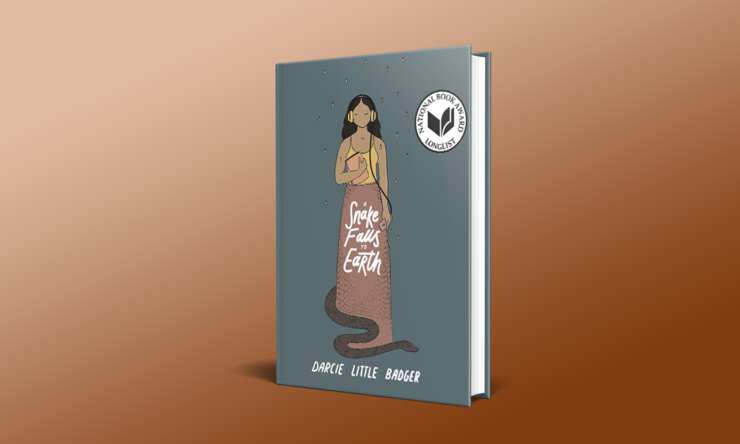In Darcie Little Badger’s second novel, the National Book Award longlisted A Snake Falls to Earth, Lipan Apache teen protagonist Nina lives in near future Texas and is smart, funny and adamant to translate her great grandmother Rosita’s ‘fanciful, ancient stories about the days when humans and spirits lived together’. Rosita was ‘the keeper of ten thousand stories, each stranger than the last’, and when she was almost impossibly old, Nina recorded her stories into an advanced translation app which is confused by the language Rosita spoken in, partly a Lipan dialect that no one can speak any longer. Nina, it seems, has to work a lot harder to understand the things her great grandmother was trying to tell her.
Meanwhile, in the Reflecting world, teenage cottonmouth snake Oli has finally been cast from his mother’s nest, and is trying to find his way independently. After a few initial hiccups, he makes a home for himself along the banks of the bottomless lake, befriends a couple of coyote sisters and a sweet, silent toad called Ami. Oli’s interactions in this world are with other animal spirits like himself, those who can shift between their true animal forms and their false human forms. All except Ami, who is mostly toad, and never shifts to his false form. It’s Ami’s sudden illness that pushes Oli and his friends to traverse the divide between their world and that of the humans, where Oli is certain he will find the cure for Ami.
The book features dual narratives, Nina’s in the human world and Oli’s in the Reflecting world, with both coming together in an exciting crescendo when Nina and Oli’s paths cross in Texas. Oli needs Nina to help him save Ami, and she needs the help of her new animal spirit friends to help her grandmother and manage a tornado that’s headed straight for them. Alongside (or perhaps branching off from) these dual stories are smaller, nesting narratives, off shoots from the main storyline, as frequently seen in oral story telling traditions when peripheral characters are given a little backstory too, as they pop in and out of the main plot lines. Tricksters, grumpy minor antagonists, messengers, monsters and magic all add wonderful texture to the main storyline and worldbuilding.
Buy the Book


A Snake Falls to Earth
The idea of sharing stories, of saving them for the future, of making sure history is not forgotten runs clear through A Snake Falls to Earth. Nina’s bookseller father gives books to spirits from the Reflecting world to take back with them, which they then transcribe and share; Rosita tells Nina Lipan Apache family stories in the oral tradition so they can be carried down through generations as the world changes; Nina translates and records stories online in a modernised version of oral storytelling via an app that shares them with the world—it’s a wonderful, steady cycle of knowing the importance of a shared cultural past, a shared tradition. ‘This is important,’ says ancient Rosalita, ‘Remember our history’.
Darcie Little Badger deftly weaves traditional elements of native American storytelling through the book, which is very much concerned with the links between the natural/human and supernatural/Reflecting world. This is especially relevant when we see that Ami’s illness and potential death are directly linked to the extinction of his breed of toads on earth when a tornado threatens to wipe out their tiny remaining earthly population. Tornadoes, we are reminded, are getting worse and more frequent, because of avoidable climate change. The earth is angry, reactive, and justifiably so.
A steady heartbeat echoes through the book, a reminder of how important a true connection to the earth is. Nina’s grandmother is unable to travel far from her home without having adverse physical reactions—her heart rate spikes dangerously when she gets a certain distance away. This idea of being so deeply rooted to your home land that you cannot leave it without being physically unwell speaks to the great respect and ties indigenous communities have to the earth, a respect that isn’t really given as much importance in mainstream society anymore, with our tendency to move and consume rapidly, the casual disposability of everything our ancestors tried to sustain but we use and discard.
A Snake Falls to Earth is an undeniably charming story, with a variety of fully realised, relatable and fun characters, each with their own authentic voice. There is no pretension in the writing, no forced attempts at being on trend, and yet it is completely relevant—whether it is that certain characters are asexual, or use the pronoun they, or the power of the internet, or whether it is the frightening, timely talk of rapid climate change and how it effects more lives than just those of humans, whether it is to remind us that our longevity as humans is intertwined with that of other species, and with that of the earth, or whether it is to remind us of what is most important, the one thing that may save us all—the power of stories, and community.
A Snake Falls to Earth is available from Levine Querido.
Mahvesh loves dystopian fiction and appropriately lives in Karachi, Pakistan. She writes about stories and interviews writers for the Tor.com podcast Midnight in Karachi when not wasting much too much time on Twitter.










